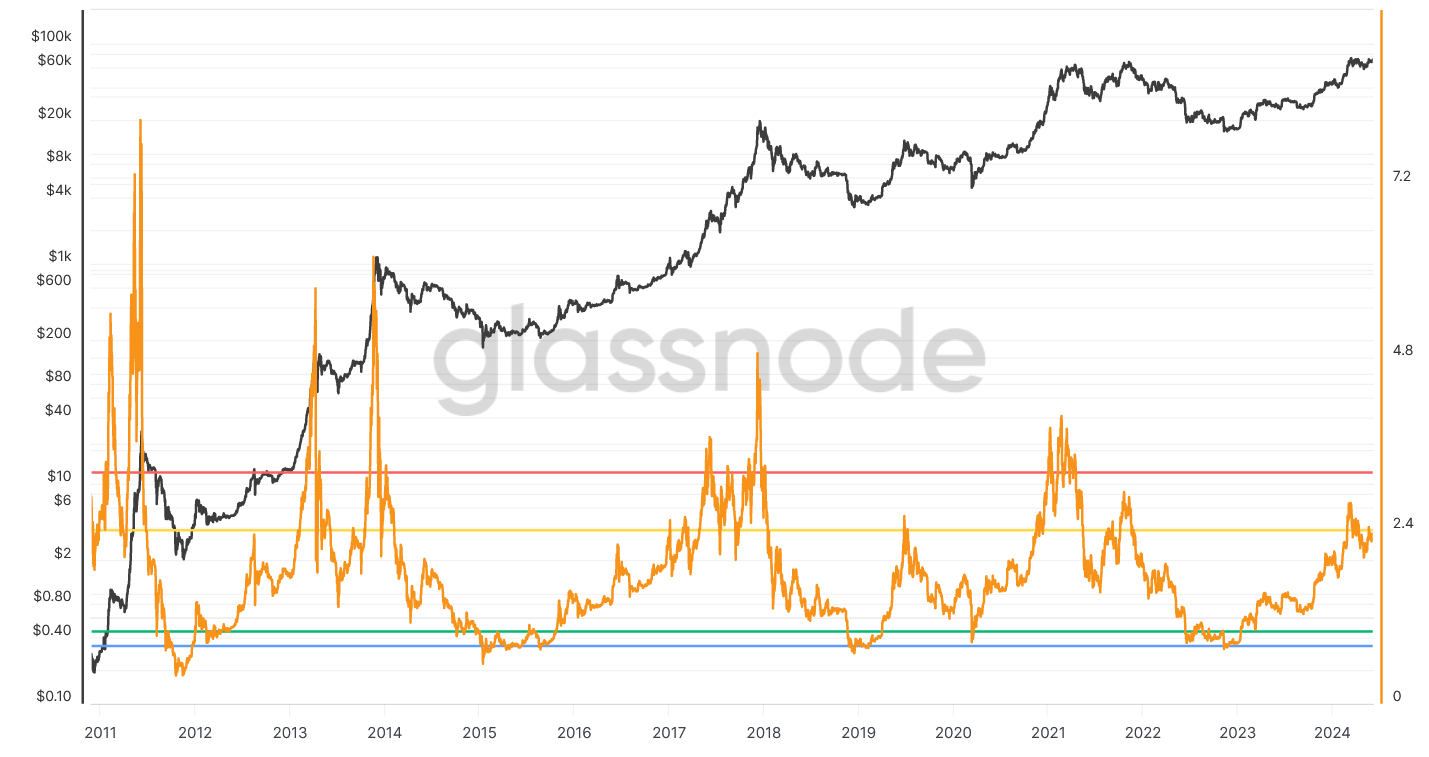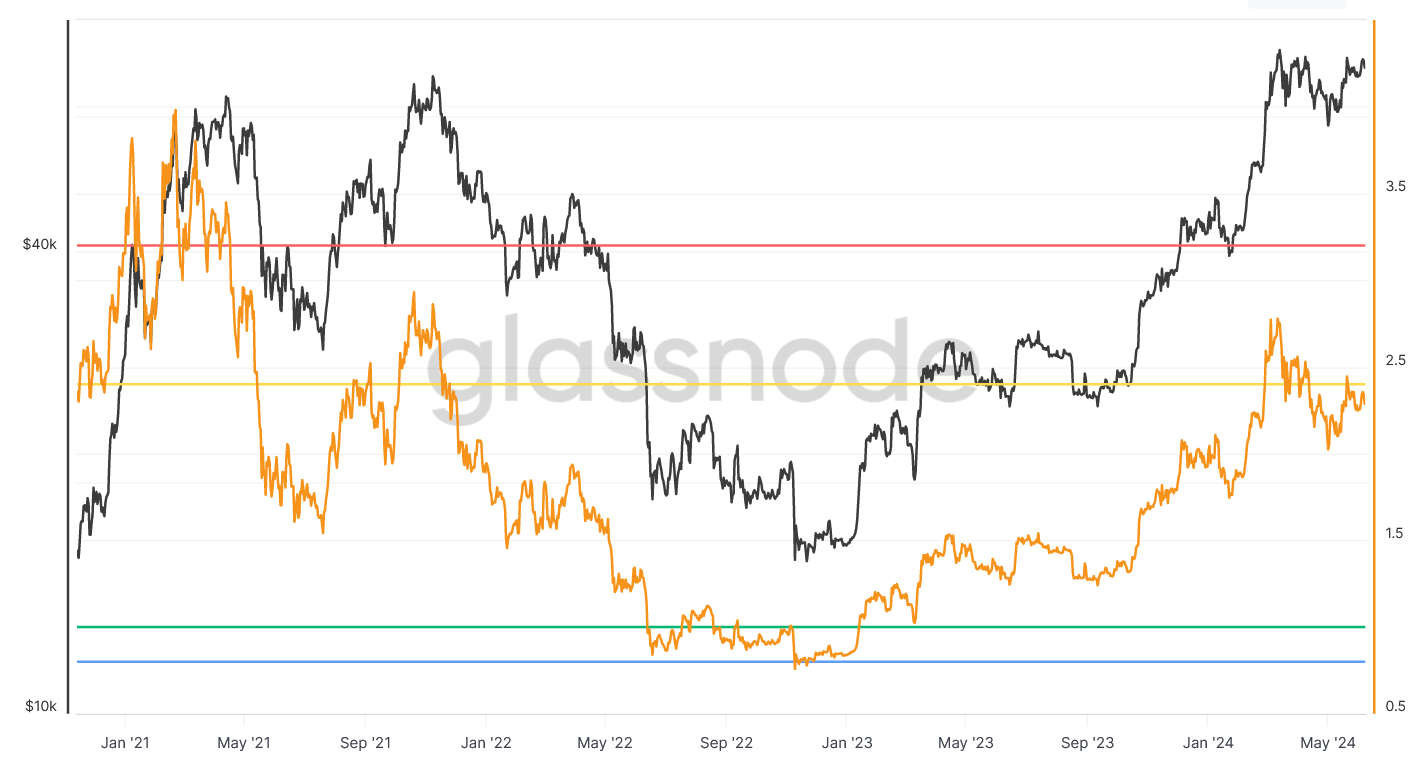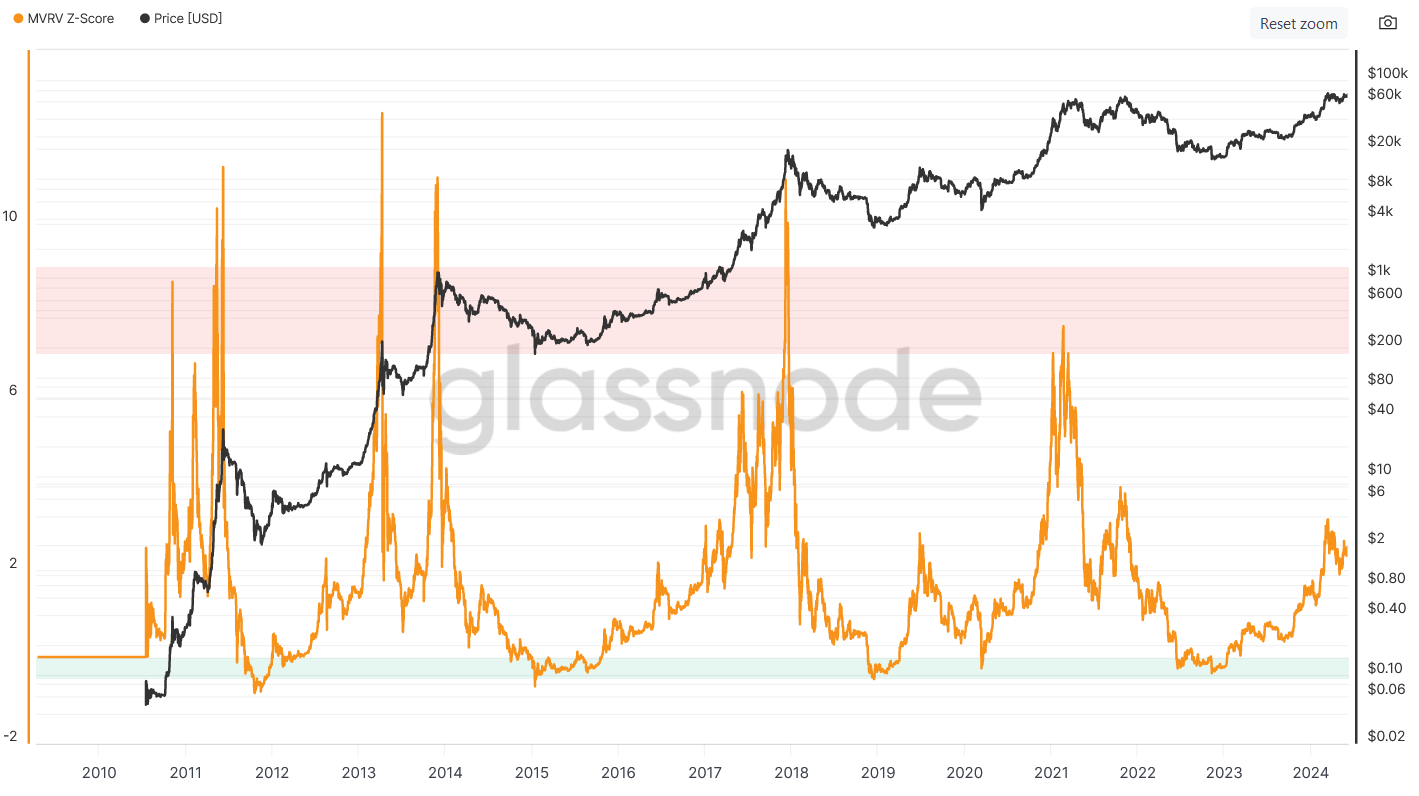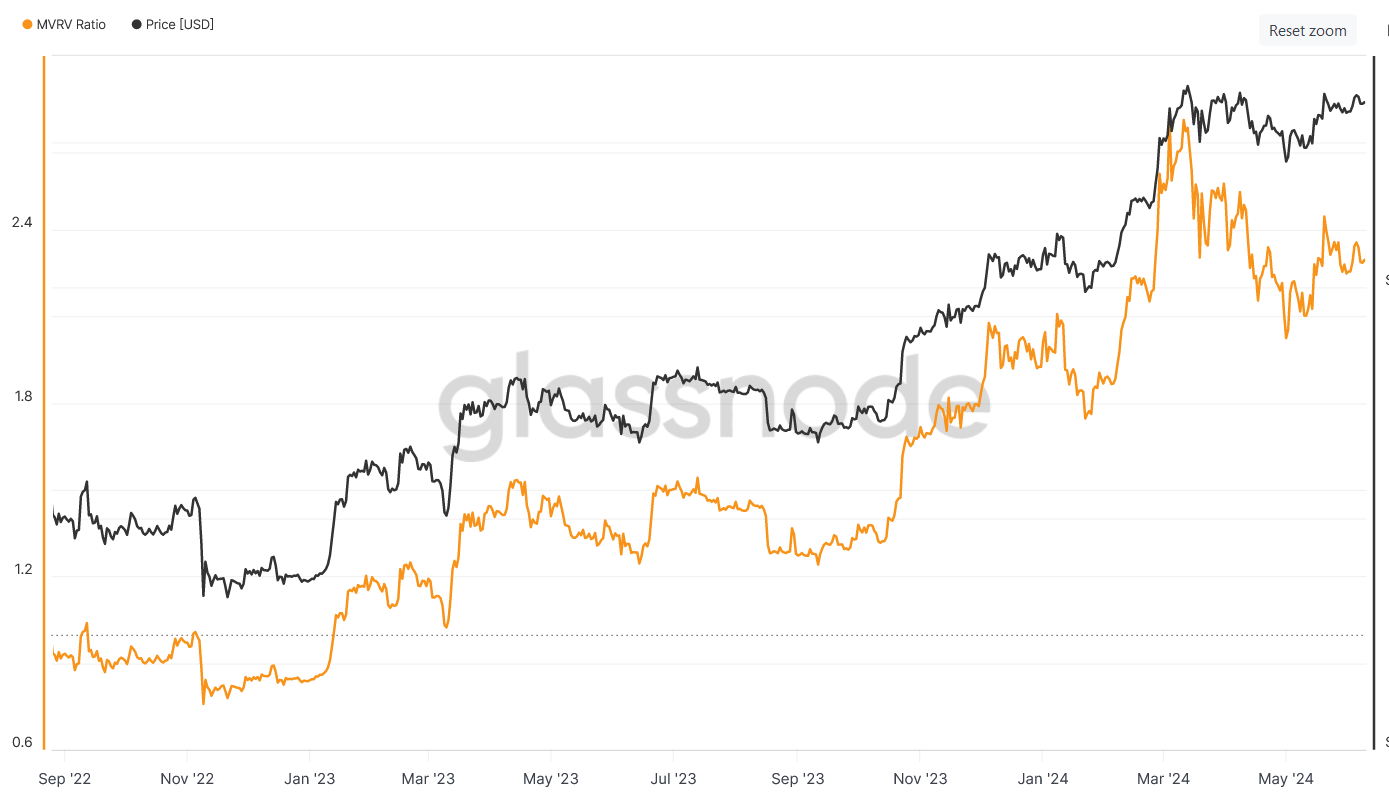How to predict Bitcoin’s price in 2024
Learn how to predict Bitcoin's price in 2024 using the MVRV ratio, an insightful on-chain metric. Discover how Market Value to Realized Value can signal.


By now, you should know that Bitcoin’s price seems to move in a more or less predictable cycle. You can use the price history chart to see where the current price stands relative to historical tops and bottoms.
Although it’s helpful to consider Bitcoin’s current price to predict its future price, it is not the only method.
Instead, we will explore something called the MVRV Ratio chart, which is a popular on-chain metric for analysing Bitcoin.
Note: Keep in mind that the contents discussed in this article are meant to be educational and serve as reference for you to consider when investing in crypto. Always do your own research before making any investment decisions.
Introducing the MVRV ratio
The MVRV ratio, or Market Value to Realised Value ratio, measures how profitable Bitcoin holders are given the current market price. This may sound complex, but don’t worry — we’ll break it down soon enough.

For now, let’s say there is a dynamic number that changes with Bitcoin’s price, and you will see an interesting pattern.
If, on average, every Bitcoin wallet is worth twice as much as when the Bitcoin was first acquired, there is a high likelihood of selling. This indicates increased selling pressure and signals an impending bear market.
But what exactly is the MVRV ratio, how is it calculated, and is it reliable for predicting market tops and bottoms? Let’s break it down.
Realised Cap vs Market Cap
Imagine two Bitcoin wallets, each containing 1 Bitcoin. At face value, both wallets are worth $10,000. However, these wallets belong to two different investors who bought their 1 BTC at different times. The first investor bought 1 Bitcoin when it was $1,000. The second bought it when it was $11,000.
Naturally, both investors are experiencing Bitcoin differently. The first investor sees a potential 10x return on investment if they liquidate their entire wallet. The second sees a $1,000 potential loss if they sell all their Bitcoin now.
Realised Cap measures all of Bitcoin’s value at the time it was acquired. If, in this case, only the two Bitcoins from the above example exist in the world, the Realised Cap would be $1,000 + $11,000 = $12,000.
Market Cap is the number you’d get if you multiply the total number of Bitcoins in existence by the current market price. If there were only two Bitcoins, the market cap would be $20,000.
You should notice that Market Cap and Realised Cap can differ significantly, not depending on Bitcoin’s current price, but rather on the price at which each Bitcoin was acquired.
What is Market Value to Realised Value?
When we combine these values, we get a ratio. This ratio will fluctuate, as you may have seen earlier.
MVRV = Market Cap / Realised Cap
The current MVRV ratio is around 2.29, according to blockchain analytics platform Glassnode. This means that, on average, Bitcoin holders are sitting on unrealized gains worth 2.29 times their initial investment. Of course, some may be experiencing a floating loss if they bought Bitcoin when it was slightly more expensive than it is now (as of June 6, 2024).
MVRV ratio signals historic tops and bottoms
Historically, when the MVRV ratio is high (e.g., above 3.5 or 3.7), there is an increased likelihood of investors selling to lock in gains. High MVRV values are often seen as a signal of potential market tops and overvaluation.
On the contrary, when the MVRV ratio is low (e.g., below 1.0), it indicates that the market value is lower than the realised value. This suggests that many investors are holding unrealized losses, signalling market bottoms and undervaluation.

Sometimes, analysts refine the model so that it fluctuates around the same value over time. This is called normalisation, which uses statistical methods. Ultimately, this leads to the development of the MVRV ratio z-score, which revolves around zero.

What they’ve found, when mapping the Bitcoin price against this chart, is that the signal becomes even clearer and more sensitive. For example, based on historical patterns, exceeding a z-score of 7 can mark the start of a market top.
Where are we now?
In the long-term timeframe, the MVRV ratio is midway between the extremes. On one hand, the MVRV and MVRV z-score suggest that we’ve passed the time when Bitcoin was at an extremely low value, making it a low-risk time to accumulate Bitcoin. On the other hand, we’re still not quite at the region where the MVRV values indicate overvaluation.

Source: Glassnode
Is it the best time to invest in Bitcoin in 2024? That depends on you. Easy Crypto doesn’t provide personalised financial advice, so do what you think (or what your actual financial advisor thinks) is best for your situation.
That being said, you must also be wary of relying on a single model like this one, as it is far from perfect. While the MVRV ratio is useful for gauging the current investment field, there are some weaknesses you should be aware of:
- The MVRV ratio only accounts for unrealized profits/losses of Bitcoin held in self-custody. It doesn’t account for investors who solely transact on centralised exchanges.
- The increasingly popular option to invest in Bitcoin ETFs may one day render the MVRV ratio less useful if large market players, whales, and even retail investors move to custodial services.
- The MVRV ratio assumes that those with unrealized profits will sell. While this may be likely for seasonal investors, long-term holders may not sell despite holding significant unrealized profits.
- Aggregating data on averages can be misleading when it comes to finances due to many outliers and extreme values. For example, large lost coin holdings including Satoshi Nakamoto’s own coins can skew the Realised Value upwards, even though they may never ever be sold.
The takeaways
The MVRV ratio and its z-score adjusted chart are useful tools we can use to estimate the relative risks of buying Bitcoin at any given moment. Historically, when the market cap is more than 3 times as high as the realised cap, there is risk of overvaluation, which gives way for a bearish signal.
However, when the market cap is a fraction of the realised cap, there is a likelihood that in this condition, investors are selling Bitcoin at a loss.
However, this shouldn’t be seen in a negative light, at least for those who are at the receiving end of the sale. In this condition, the buyers would have acquired Bitcoin at a great discount.
If you had bought Bitcoin when the MVRV ratio is less than one, you may have been one of those buyers who are sitting on unrealised gains.
Further reading: Explore more topics on all things crypto.
Share to
Stay curious and informed
Your info will be handled according to our Privacy Policy.
Make sure to follow our Twitter, Instagram, and YouTube channel to stay up-to-date with Easy Crypto!
Also, don’t forget to subscribe to our monthly newsletter to have the latest crypto insights, news, and updates delivered to our inbox.
Disclaimer: Information is current as at the date of publication. This is general information only and is not intended to be advice. Crypto is volatile, carries risk and the value can go up and down. Past performance is not an indicator of future returns. Please do your own research.
Last updated June 12, 2024





